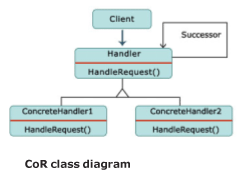|
|
|
Design Pattern |
| |
Behavioral Patterns
Behavioral patterns are those patterns, which
are specifically concerned with communication
(interaction) between the objects. The
interactions between the objects should be such
that they are talking to each other and are still
loosely coupled. The loose coupling is the key
to n-tier architectures. In this, the
implementations and the client should be loosely
coupled in order to avoid hard coding and
dependencies. The behavioral patterns are:
1. Chain of Responsibility Pattern
2. Command Pattern
3. Interpreter Pattern
4. Iterator Pattern
5. Mediator Pattern
6. Momento Pattern
7. Observer Pattern
8. State Pattern
9. Strategy Pattern
10. Template Pattern
11. Visitor Pattern
Some of the important and useful pattern
which are frequently used in java are as
under:
Chain of Responsibility pattern:
As per concern the Object Oriented Design, it
is a design pattern based on chain that consists
a source of command objects and a series of
processing objects. In this pattern, each
processing object holds a set of logic, which
describes the kinds of command objects. These
Objects are in the form of a chain that forwards
the request until one of the objects handles
the event.
In other words, this pattern decouples the
sender who sends the requested data. The
receiver or any members of the “chain” pick that
data. If the first link of the chain cannot handle
the responsibility, it passes the request data to
the next level in the chain, i.e. to the next link
until one of the objects handles the event. This
is similar to concepts Exception Hierarchy in Java.
This technique is called “data-driven”. In most
of the behavioral patterns, the data-driven
concepts are used to have a loose coupling. |
|
including a new processing object to the end of
this chain.
The Chain of Responsibility pattern is applicable
if:
1. We want to decouple a request’s sender
and receiver.
2. We don’t want to assign handlers
explicitly in our code.
3. Multiple objects are nominees to handle
a request at runtime.
There are some key points to remember when
we use the Chain of responsibility pattern like
only one object in the chain handles a
request. There are also some possibilities for
some requests might not get handled.
“Avoid coupling the sender of a request to its
receiver by giving more than one object a
chance to handle the request. Chain the
receiving objects and pass the request along
the chain until an object handles it.”

A typical object structure of chain of
responsibility is shown as:
|
|
Dec
2007 | Java Jazz Up | 65 |
|
| |
| View All Topics |
| All Pages of this Issue |
Pages:
1,
2,
3,
4,
5,
6,
7,
8,
9,
10,
11,
12,
13,
14,
15,
16,
17,
18,
19,
20,
21,
22,
23,
24,
25,
26,
27,
28,
29,
30,
31,
32,
33,
34,
35,
36,
37,
38,
39,
40,
41,
42,
43,
44,
45,
46,
47,
48,
49,
50,
51,
52,
53 ,
54,
55,
56,
57,
58,
59,
60,
61,
62,
63 ,
64,
65 ,
66 ,
67 ,
68 ,
69 ,
70 ,
71 ,
72 ,
73 ,
74 ,
75 ,
76 ,
77 ,
78 ,
79 ,
80 ,
81 ,
82 ,
Download PDF |
|
|
|
|
|
|
| |
| |
|